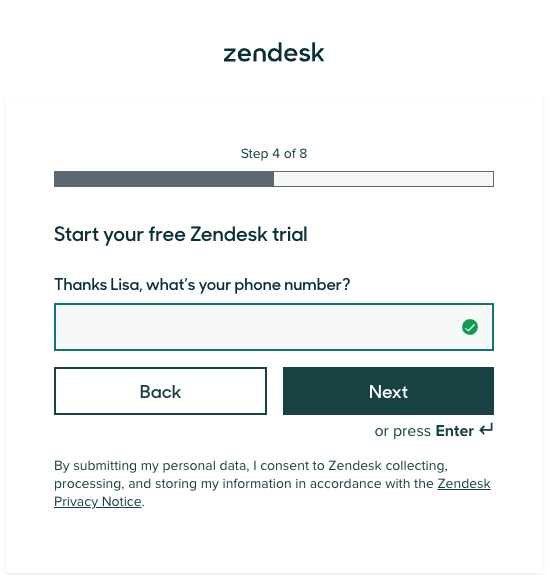What Is Microcopy?
Microcopy refers to the small but important snippets of text that provide context for users as they move through a website or product experience. These include button and CTA text, tips, confirmations, form labels, placeholders, error messages, and empty states, to name just a few.
When done right, it can:
- Entice the user to click through to the next screen
- Reduce friction
- Clear up confusion
- Reinforce your brand voice
- Provide small moments of delight that help users connect with your brand
2 Examples of Microcopy
Click the two images below to see what good microcopy looks like on the page.

Zendesk example: Marketers know that lead capture forms are a common place to lose potential customers who don’t like to fill out forms and may click the “Back” button when faced with one. In addition to design best practices (like keeping the form short and sweet and including a progress bar), Zendesk keeps the user motivated with this short, well-placed message of gratitude and encouragement: “Thanks Lisa, what’s your phone number?”

Microsoft Outlook example: Empty screens are another potential friction point in a typical product experience. New users may not know how to get started when faced with an empty screen, and even regular users may wonder why no items are displayed. To avoid confusion (and maybe prompt a smile), Microsoft Outlook displays the message, “All done for the day! Enjoy your empty inbox.” with an image of a hot air balloon when your inbox is empty.
What’s the Difference between Microcopy and UX Writing?
As we’ve just seen, microcopy and UX writing are closely linked, but there are subtle differences between the two. UX writing is any copy that guides the user through a product experience, including longer-form copy that wouldn’t be considered microcopy, such as instructional text, help articles, and product-generated emails.
Microcopy is a subcategory of UX writing. It includes all the interactive UI text that makes up the product experience itself. Often overlooked in the past by designers and marketers alike, these short and unassuming pieces of text deserve our focus. In addition to their role in upholding UX and usability principles, both microcopy and UX writing are powerful engines for conveying the brand voice and achieving marketing goals.
Why It Matters for B2B Marketing
Now that microcopy is getting some well-deserved attention, it’s in the middle of a tug-of-war between UX designers and marketers, who each have their own ideas about how to write this type of copy. Marketers see it as a place to showcase the brand’s personality and provide a human touch, while UX professionals argue that branding can’t come at the expense of the user experience.
Actually, microcopy can do both. In fact, it isn’t effective without consideration for both the brand voice and the user experience.
Microcopy matters for branding, but it matters even more as a way to reduce friction in the content experience and help users as they move toward their goals. You might think that microcopy is only for consumer products, but think about it: Which organizations have the longest buying cycles, the most friction-filled content experiences, and the most complicated products? That’s right—B2B ones. Good microcopy can keep users engaged, guide them through confusing tasks, and make them feel good about the product.
Need Help Writing Copy That Engages and Converts?
Use Tendo to produce clear and concise microcopy that enhances the user experience. The world’s leading B2B brands rely on our user experience and editorial services to better serve their customers. Get in touch to learn how we can help you meet your needs and goals. Contact us today.

